Mangiferin Induces Post-Implant Osteointegration in Male Diabetic Rats
Abstract
1. Introduction
2. Materials and Methods
2.1. Animals
2.2. Implant Placement
2.3. Study Protocol
2.4. Biochemical Measurements
2.5. Gene Expressions with Real-Time Polymerase Chain Reaction
2.6. Imaging of the Bone–Implant Complex
2.7. Immunohistochemistry
2.8. Histochemical Staining
2.9. Statistical Analysis
3. Results
3.1. Metabolic and Biochemical Parameters
3.2. mRNA Expressions of Bone Markers
3.3. Imaging of the Bone–Implant Complex
3.4. Immunohistochemistry
3.5. Histochemical Staining
4. Discussion
5. Conclusions
Author Contributions
Funding
Institutional Review Board Statement
Informed Consent Statement
Data Availability Statement
Acknowledgments
Conflicts of Interest
Abbreviations
References
- Barquilla García, A. Brief Update on Diabetes for General Practitioners. Rev. Esp. Sanid. Penit. 2017, 19, 57–65. [Google Scholar] [CrossRef]
- Koca, H.; Pektas, M.; Koca, S.; Pektas, G.; Sadi, G. Diabetes-Induced Renal Failure Is Associated with Tissue Inflammation and Neutrophil Gelatinase-Associated Lipocalin: Effects of Resveratrol. Arch. Biol. Sci. 2016, 68, 747–752. [Google Scholar] [CrossRef]
- Pektaş, A.; Pektaş, M.B.; Koca, H.B.; Tosun, M.; Aslan, E.; Koca, S.; Sadi, G. Effects of Resveratrol on Diabetes-Induced Vascular Tissue Damage and Inflammation in Male Rats. Turk. J. Biochem. 2017, 42, 451–458. [Google Scholar] [CrossRef]
- Pektas, M.B.; Turan, O.; Ozturk Bingol, G.; Sumlu, E.; Sadi, G.; Akar, F. High Glucose Causes Vascular Dysfunction through Akt/ENOS Pathway: Reciprocal Modulation by Juglone and Resveratrol. Can. J. Physiol. Pharmacol. 2018, 96, 757–764. [Google Scholar] [CrossRef]
- Yue, Z.; Nie, L.; Ji, N.; Sun, Y.; Zhu, K.; Zou, H.; Song, X.; Chen, J.; Wang, Q. Hyperglycaemia Aggravates Periodontal Inflamm-aging by Promoting SETDB1-mediated LINE-1 De-repression in Macrophages. J. Clin. Periodontol. 2023, 50, 1685–1696. [Google Scholar] [CrossRef] [PubMed]
- Pihlstrom, B.L.; Michalowicz, B.S.; Johnson, N.W. Periodontal Diseases. Lancet 2005, 366, 1809–1820. [Google Scholar] [CrossRef] [PubMed]
- Nishikawa, T.; Suzuki, Y.; Sawada, N.; Kobayashi, Y.; Nakamura, N.; Miyabe, M.; Miyajima, S.; Adachi, K.; Minato, T.; Mizutani, M.; et al. Therapeutic Potential for Insulin on Type 1 Diabetes-associated Periodontitis: Analysis of Experimental Periodontitis in Streptozotocin-induced Diabetic Rats. J. Diabetes Investig. 2020, 11, 1482–1489. [Google Scholar] [CrossRef]
- Cramer, C.; Freisinger, E.; Jones, R.K.; Slakey, D.P.; Dupin, C.L.; Newsome, E.R.; Alt, E.U.; Izadpanah, R. Persistent High Glucose Concentrations Alter the Regenerative Potential of Mesenchymal Stem Cells. Stem Cells Dev. 2010, 19, 1875–1884. [Google Scholar] [CrossRef]
- Wang, Q.; Li, H.; Xiao, Y.; Li, S.; Li, B.; Zhao, X.; Ye, L.; Guo, B.; Chen, X.; Ding, Y.; et al. Locally Controlled Delivery of TNFα Antibody from a Novel Glucose-Sensitive Scaffold Enhances Alveolar Bone Healing in Diabetic Conditions. J. Control. Release 2015, 206, 232–242. [Google Scholar] [CrossRef] [PubMed]
- Kim, H.J.; Jung, B.H.; Yoo, K.-Y.; Han, J.-W.; Um, H.-S.; Chang, B.-S.; Lee, J.-K. Determination of the Critical Diabetes Duration in a Streptozotocin-Induced Diabetic Rat Calvarial Defect Model for Experimentation Regarding Bone Regeneration. J. Periodontal Implant Sci. 2017, 47, 339–350. [Google Scholar] [CrossRef] [PubMed]
- Ekici, O.; Aslan, E.; Guzel, H.; Korkmaz, O.A.; Sadi, G.; Gurol, A.M.; Boyaci, M.G.; Pektas, M.B. Kefir Alters Craniomandibular Bone Development in Rats Fed Excess Dose of High Fructose Corn Syrup. J. Bone Miner. Metab. 2022, 40, 56–65. [Google Scholar] [CrossRef] [PubMed]
- Ekici, Ö.; Aslan, E.; Aladağ, T.; Güzel, H.; Korkmaz, Ö.A.; Bostancı, A.; Sadi, G.; Pektaş, M.B. Masseter Muscle and Gingival Tissue Inflammatory Response Following Treatment with High-fructose Corn Syrup in Rats: Anti-inflammatory and Antioxidant Effects of Kefir. J. Food Biochem. 2022, 46, e13732. [Google Scholar] [CrossRef] [PubMed]
- Tan, S.J.; Baharin, B.; Mohd, N.; Nabil, S. Effect of Anti-Diabetic Medications on Dental Implants: A Scoping Review of Animal Studies and Their Relevance to Humans. Pharmaceuticals 2022, 15, 1518. [Google Scholar] [CrossRef]
- Fretwurst, T.; Nelson, K. Influence of Medical and Geriatric Factors on Implant Success: An Overview of Systematic Reviews. Int. J. Prosthodont. 2021, 34, s21–s26. [Google Scholar] [CrossRef]
- Lv, X.; Zou, L.; Zhang, X.; Zhang, X.; Lai, H.; Shi, J. Effects of Diabetes/Hyperglycemia on Peri-implant Biomarkers and Clinical and Radiographic Outcomes in Patients with Dental Implant Restorations: A Systematic Review and Meta-analysis. Clin. Oral Implants Res. 2022, 33, 1183–1198. [Google Scholar] [CrossRef]
- Aswal, S.; Kumar, A.; Chauhan, A.; Semwal, R.B.; Kumar, A.; Semwal, D.K. A Molecular Approach on the Protective Effects of Mangiferin against Diabetes and Diabetes-Related Complications. Curr. Diabetes Rev. 2020, 16, 690–698. [Google Scholar] [CrossRef]
- Du, S.; Liu, H.; Lei, T.; Xie, X.; Wang, H.; He, X.; Tong, R.; Wang, Y. Mangiferin: An Effective Therapeutic Agent against Several Disorders. Mol. Med. Rep. 2018, 18, 4775–4786. [Google Scholar] [CrossRef] [PubMed]
- Jagetia, G.C.; Baliga, M.S. Radioprotection by Mangiferin in DBAxC57BL Mice: A Preliminary Study. Phytomedicine 2005, 12, 209–215. [Google Scholar] [CrossRef] [PubMed]
- Saha, S.; Sadhukhan, P.; Sil, P.C. Mangiferin: A Xanthonoid with Multipotent Anti-inflammatory Potential. BioFactors 2016, 42, 459–474. [Google Scholar] [CrossRef]
- Sellamuthu, P.S.; Arulselvan, P.; Fakurazi, S.; Kandasamy, M. Beneficial Effects of Mangiferin Isolated from Salacia Chinensis on Biochemical and Hematological Parameters in Rats with Streptozotocin-Induced Diabetes. Pak. J. Pharm. Sci. 2014, 27, 161–167. [Google Scholar]
- Zhang, P.; Li, T.; Wu, X.; Nice, E.C.; Huang, C.; Zhang, Y. Oxidative Stress and Diabetes: Antioxidative Strategies. Front. Med. 2020, 14, 583–600. [Google Scholar] [CrossRef] [PubMed]
- Liu, S.; Fang, T.; Yang, L.; Chen, Z.; Mu, S.; Fu, Q. Gastrodin Protects MC3T3-E1 Osteoblasts from Dexamethasone-Induced Cellular Dysfunction and Promotes Bone Formation via Induction of the NRF2 Signaling Pathway. Int. J. Mol. Med. 2018, 41, 2059–2069. [Google Scholar] [CrossRef]
- Li, X.; Ma, X.-Y.; Feng, Y.-F.; Ma, Z.-S.; Wang, J.; Ma, T.-C.; Qi, W.; Lei, W.; Wang, L. Osseointegration of Chitosan Coated Porous Titanium Alloy Implant by Reactive Oxygen Species-Mediated Activation of the PI3K/AKT Pathway under Diabetic Conditions. Biomaterials 2015, 36, 44–54. [Google Scholar] [CrossRef] [PubMed]
- An, Y.; Zhang, H.; Wang, C.; Jiao, F.; Xu, H.; Wang, X.; Luan, W.; Ma, F.; Ni, L.; Tang, X.; et al. Activation of ROS/MAPKs/NF-ΚB/NLRP3 and Inhibition of Efferocytosis in Osteoclast-Mediated Diabetic Osteoporosis. FASEB J. 2019, 33, 12515–12527. [Google Scholar] [CrossRef] [PubMed]
- Zivković, J.; Kumar, K.A.; Rushendran, R.; Ilango, K.; Fahmy, N.M.; El-Nashar, H.A.S.; El-Shazly, M.; Ezzat, S.M.; Melgar-Lalanne, G.; Romero-Montero, A.; et al. Pharmacological Properties of Mangiferin: Bioavailability, Mechanisms of Action and Clinical Perspectives. Naunyn-Schmiedeberg’s Arch. Pharmacol. 2023, 392, 763–781. [Google Scholar] [CrossRef]
- Gálvez-Rodríguez, A.; Ferino-Pérez, A.; Rodríguez-Riera, Z.; Rodeiro Guerra, I.; Řeha, D.; Minofar, B.; Jáuregui-Haza, U.J. Explaining the Interaction of Mangiferin with MMP-9 and NF-Ƙβ: A Computational Study. J. Mol. Model. 2022, 28, 266. [Google Scholar] [CrossRef]
- Li, H.; Wang, Q.; Ding, Y.; Bao, C.; Li, W. Mangiferin Ameliorates Porphyromonas Gingivalis -induced Experimental Periodontitis by Inhibiting Phosphorylation of Nuclear Factor-κB and Janus Kinase 1–Signal Transducer and Activator of Transcription Signaling Pathways. J. Periodontal Res. 2017, 52, 1–7. [Google Scholar] [CrossRef] [PubMed]
- Sarkar, A.; Sreenivasan, Y.; Ramesh, G.T.; Manna, S.K. β-d-Glucoside Suppresses Tumor Necrosis Factor-Induced Activation of Nuclear Transcription Factor ΚB but Potentiates Apoptosis. J. Biol. Chem. 2004, 279, 33768–33781. [Google Scholar] [CrossRef] [PubMed]
- Li, H.; Wang, Q.; Chen, X.; Ding, Y.; Li, W. Mangiferin Inhibits Lipopolysaccharide-Induced Production of Interleukin-6 in Human Oral Epithelial Cells by Suppressing Toll-like Receptor Signaling. Arch. Oral Biol. 2016, 71, 155–161. [Google Scholar] [CrossRef]
- Huh, J.-E.; Koh, P.-S.; Seo, B.-K.; Park, Y.-C.; Baek, Y.-H.; Lee, J.-D.; Park, D.-S. Mangiferin Reduces the Inhibition of Chondrogenic Differentiation by IL-1β in Mesenchymal Stem Cells from Subchondral Bone and Targets Multiple Aspects of the Smad and SOX9 Pathways. Int. J. Mol. Sci. 2014, 15, 16025–16042. [Google Scholar] [CrossRef]
- Ang, E.; Liu, Q.; Qi, M.; Liu, H.G.; Yang, X.; Chen, H.; Zheng, M.H.; Xu, J. Mangiferin Attenuates Osteoclastogenesis, Bone Resorption, and RANKL-induced Activation of NF-κB and ERK. J. Cell. Biochem. 2011, 112, 89–97. [Google Scholar] [CrossRef] [PubMed]
- The Regulation of the Welfare and Protection of Animals Used for Experimental and Other Scientific Purposes; Turkish Official Gazette: Ankara, Turkey, 2011. Available online: http://www.resmigazete.gov.tr/eskiler/2011/12/20111213-4.html (accessed on 9 June 2024).
- Vandorsten, J.P.; Dodson, W.C.; Espeland, M.A.; Grobman, W.A.; Guise, J.M.; Mercer, B.M.; Minkoff, H.L.; Poindexter, B.; Prosser, L.A.; Sawaya, G.F.; et al. NIH Consensus Development Conference: Diagnosing Gestational Diabetes Mellitus. NIH Consens. State Sci. Statements 2013, 29, 1–31. [Google Scholar] [PubMed]
- Mark, I.; Dym, H.; Fan, Y. Immediate Restoration of an Endosseous Implant. Dent. Clin. N. Am. 2024, 68, 203–212. [Google Scholar] [CrossRef] [PubMed]
- Fernandes, A.; Rodrigues, P.M.; Pintado, M.; Tavaria, F.K. A Systematic Review of Natural Products for Skin Applications: Targeting Inflammation, Wound Healing, and Photo-Aging. Phytomedicine 2023, 115, 154824. [Google Scholar] [CrossRef] [PubMed]
- Kompoura, V.; Prapa, I.; Vasilakopoulou, P.B.; Mitropoulou, G.; Nelios, G.; Balafas, E.; Kostomitsopoulos, N.; Chiou, A.; Karathanos, V.T.; Bezirtzoglou, E.; et al. Corinthian Currants Supplementation Restores Serum Polar Phenolic Compounds, Reduces IL-1beta, and Exerts Beneficial Effects on Gut Microbiota in the Streptozotocin-Induced Type-1 Diabetic Rat. Metabolites 2023, 13, 415. [Google Scholar] [CrossRef] [PubMed]
- Roy, J.R.; Janaki, C.S.; Jayaraman, S.; Veeraraghavan, V.P.; Periyasamy, V.; Balaji, T.; Vijayamalathi, M.; Bhuvaneswari, P.; Swetha, P. Hypoglycemic Potential of Carica Papaya in Liver Is Mediated through IRS-2/PI3K/SREBP-1c/GLUT2 Signaling in High-Fat-Diet-Induced Type-2 Diabetic Male Rats. Toxics 2023, 11, 240. [Google Scholar] [CrossRef] [PubMed]
- Zhang, Y.; Wang, R.; Yao, H.; Ma, N.; Jiang, C.; Zhou, Y.; Xia, Z.; Liu, Q.; Liu, Q.; Lu, W.; et al. Mangiferin Ameliorates HFD-Induced NAFLD through Regulation of the AMPK and NLRP3 Inflammasome Signal Pathways. J. Immunol. Res. 2021, 2021, 4084566. [Google Scholar] [CrossRef]
- Kottaisamy, C.P.D.; Raj, D.S.; Prasanth Kumar, V.; Sankaran, U. Experimental Animal Models for Diabetes and Its Related Complications-a Review. Lab. Anim. Res. 2021, 37, 23. [Google Scholar] [CrossRef]
- Wang, M.; Liang, Y.; Chen, K.; Wang, M.; Long, X.; Liu, H.; Sun, Y.; He, B. The Management of Diabetes Mellitus by Mangiferin: Advances and Prospects. Nanoscale 2022, 14, 2119–2135. [Google Scholar] [CrossRef]
- Li, J.; Chen, J.; Kirsner, R. Pathophysiology of Acute Wound Healing. Clin. Dermatol. 2007, 25, 9–18. [Google Scholar] [CrossRef]
- King, S.; Baptiston Tanaka, C.; Ross, D.; Kruzic, J.J.; Levinger, I.; Klineberg, I.; Brennan-Speranza, T.C. A Diet High in Fat and Fructose Adversely Affects Osseointegration of Titanium Implants in Rats. Clin. Exp. Dent. Res. 2020, 6, 107–116. [Google Scholar] [CrossRef] [PubMed]
- Zhang, J.; Wang, Y.; Jia, T.; Huang, H.; Zhang, D.; Xu, X. Genipin and Insulin Combined Treatment Improves Implant Osseointegration in Type 2 Diabetic Rats. J. Orthop. Surg. Res. 2021, 16, 59. [Google Scholar] [CrossRef]
- Wu, Y.; Liu, W.; Yang, T.; Li, M.; Qin, L.; Wu, L.; Liu, T. Oral Administration of Mangiferin Ameliorates Diabetes in Animal Models: A Meta-Analysis and Systematic Review. Nutr. Res. 2021, 87, 57–69. [Google Scholar] [CrossRef] [PubMed]
- Jiang, F.; Zhang, D.; Jia, M.; Hao, W.; Li, Y. Mangiferin Inhibits High-Fat Diet Induced Vascular Injury via Regulation of PTEN/AKT/ENOS Pathway. J. Pharmacol. Sci. 2018, 137, 265–273. [Google Scholar] [CrossRef] [PubMed]
- Shi, J.; Lv, H.; Tang, C.; Li, Y.; Huang, J.; Zhang, H. Mangiferin Inhibits Cell Migration and Angiogenesis via PI3K/AKT/MTOR Signaling in High Glucose- and Hypoxia-induced RRCECs. Mol. Med. Rep. 2021, 23, 473. [Google Scholar] [CrossRef]
- Wen, J.; Qin, Y.; Li, C.; Dai, X.; Wu, T.; Yin, W. Mangiferin Suppresses Human Metastatic Osteosarcoma Cell Growth by Down-Regulating the Expression of Metalloproteinases-1/2 and Parathyroid Hormone Receptor 1. AMB Express 2020, 10, 13. [Google Scholar] [CrossRef]
- Chen, L.; Li, S.; Zhu, J.; You, A.; Huang, X.; Yi, X.; Xue, M. Mangiferin Prevents Myocardial Infarction-induced Apoptosis and Heart Failure in Mice by Activating the Sirt1/FoxO3a Pathway. J. Cell. Mol. Med. 2021, 25, 2944–2955. [Google Scholar] [CrossRef]
- Hou, J.; Zheng, D.; Fung, G.; Deng, H.; Chen, L.; Liang, J.; Jiang, Y.; Hu, Y. Mangiferin Suppressed Advanced Glycation End Products (AGEs) through NF-ΚB Deactivation and Displayed Anti-Inflammatory Effects in Streptozotocin and High Fat Diet-Diabetic Cardiomyopathy Rats. Can. J. Physiol. Pharmacol. 2016, 94, 332–340. [Google Scholar] [CrossRef]
- Takeda, T.; Tsubaki, M.; Kino, T.; Yamagishi, M.; Iida, M.; Itoh, T.; Imano, M.; Tanabe, G.; Muraoka, O.; Satou, T.; et al. Mangiferin Induces Apoptosis in Multiple Myeloma Cell Lines by Suppressing the Activation of Nuclear Factor Kappa B-Inducing Kinase. Chem. Biol. Interact. 2016, 251, 26–33. [Google Scholar] [CrossRef]
- Pleguezuelos-Villa, M.; Nácher, A.; Hernández, M.J.; Ofelia Vila Buso, M.A.; Ruiz Sauri, A.; Díez-Sales, O. Mangiferin Nanoemulsions in Treatment of Inflammatory Disorders and Skin Regeneration. Int. J. Pharm. 2019, 564, 299–307. [Google Scholar] [CrossRef]
- Lwin, O.M.; Giribabu, N.; Kilari, E.K.; Salleh, N. Topical Administration of Mangiferin Promotes Healing of the Wound of Streptozotocin-Nicotinamide-Induced Type-2 Diabetic Male Rats. J. Dermatolog. Treat. 2021, 32, 1039–1048. [Google Scholar] [CrossRef] [PubMed]
- Tan, H.-Y.; Wang, N.; Li, S.; Hong, M.; Guo, W.; Man, K.; Cheng, C.; Chen, Z.; Feng, Y. Repression of WT1-Mediated LEF1 Transcription by Mangiferin Governs β-Catenin-Independent Wnt Signalling Inactivation in Hepatocellular Carcinoma. Cell. Physiol. Biochem. 2018, 47, 1819–1834. [Google Scholar] [CrossRef] [PubMed]
- El-Sayyad, S.M.; Soubh, A.A.; Awad, A.S.; El-Abhar, H.S. Mangiferin Protects against intestinal Ischemia/Reperfusion-Induced liver Injury: Involvement of PPAR-γ, GSK-3β and Wnt/β-Catenin Pathway. Eur. J. Pharmacol. 2017, 809, 80–86. [Google Scholar] [CrossRef] [PubMed]
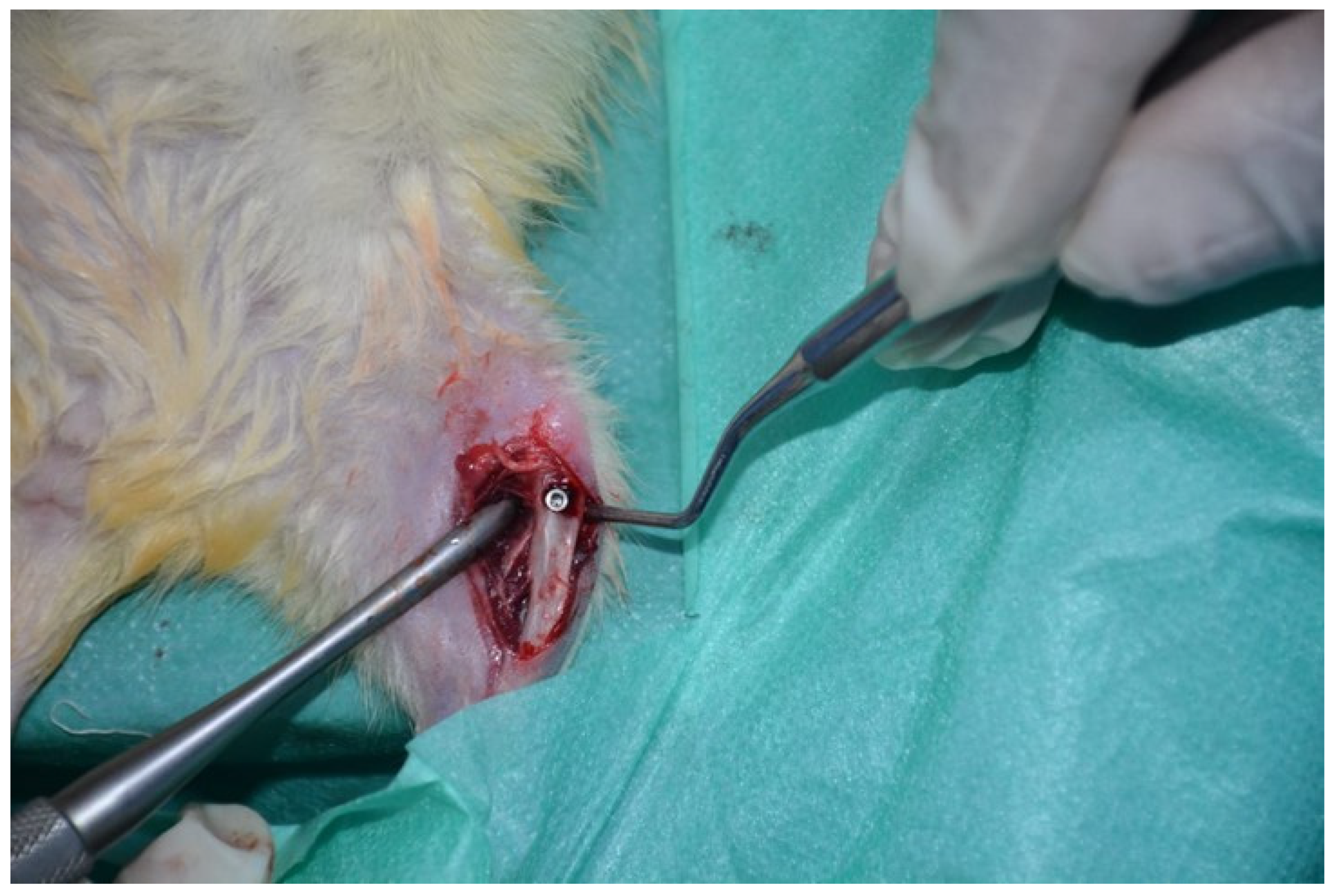
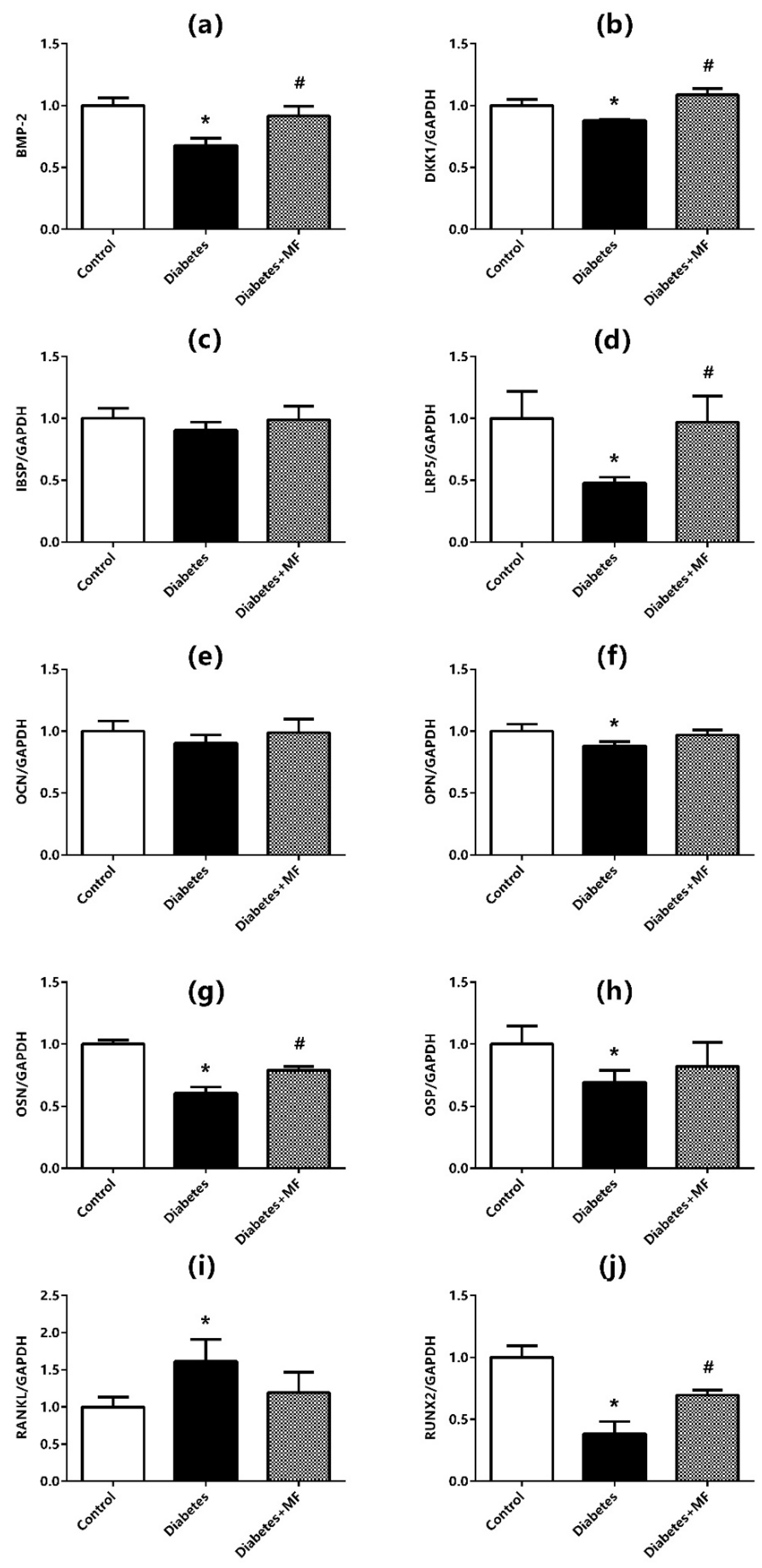
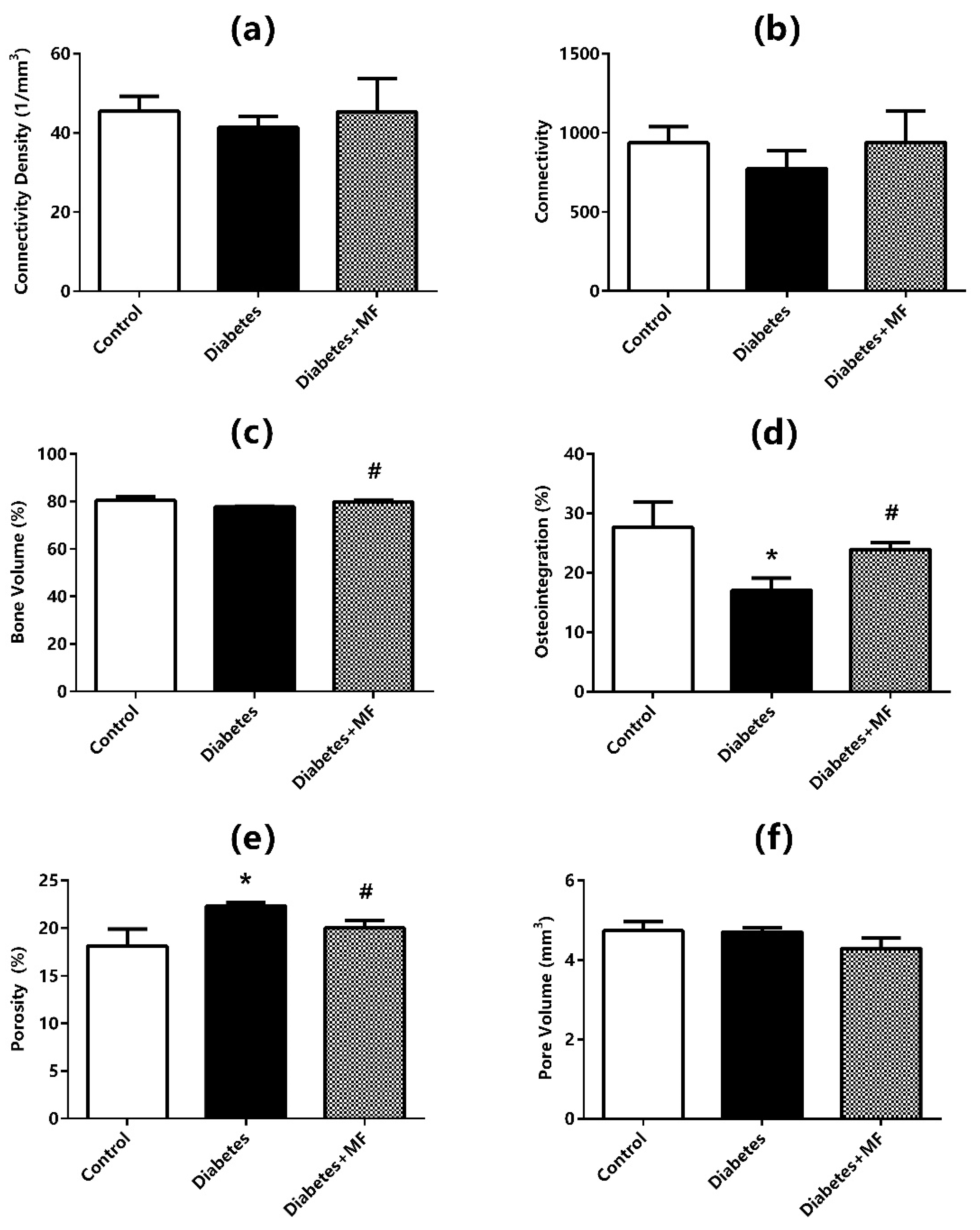
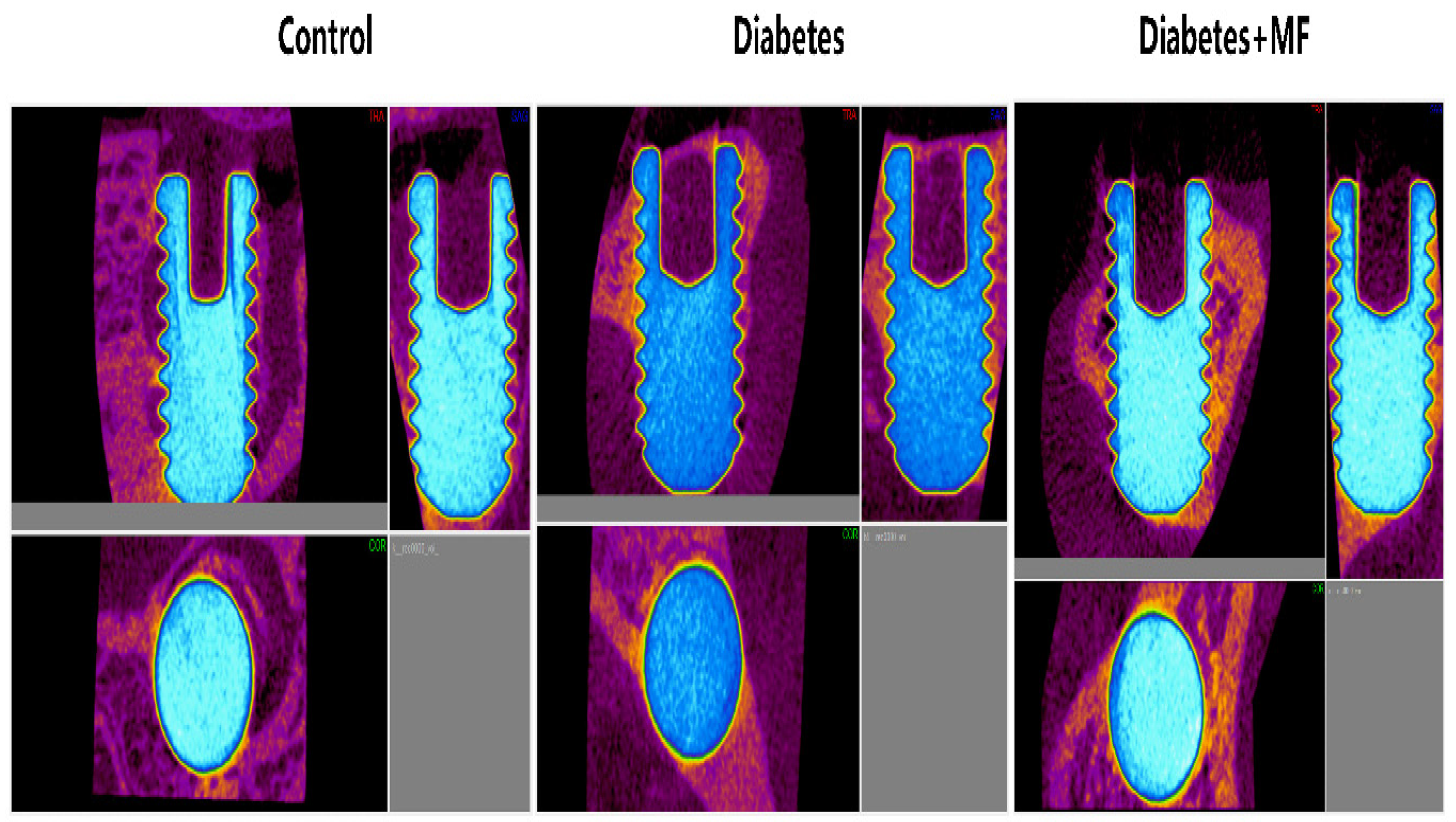
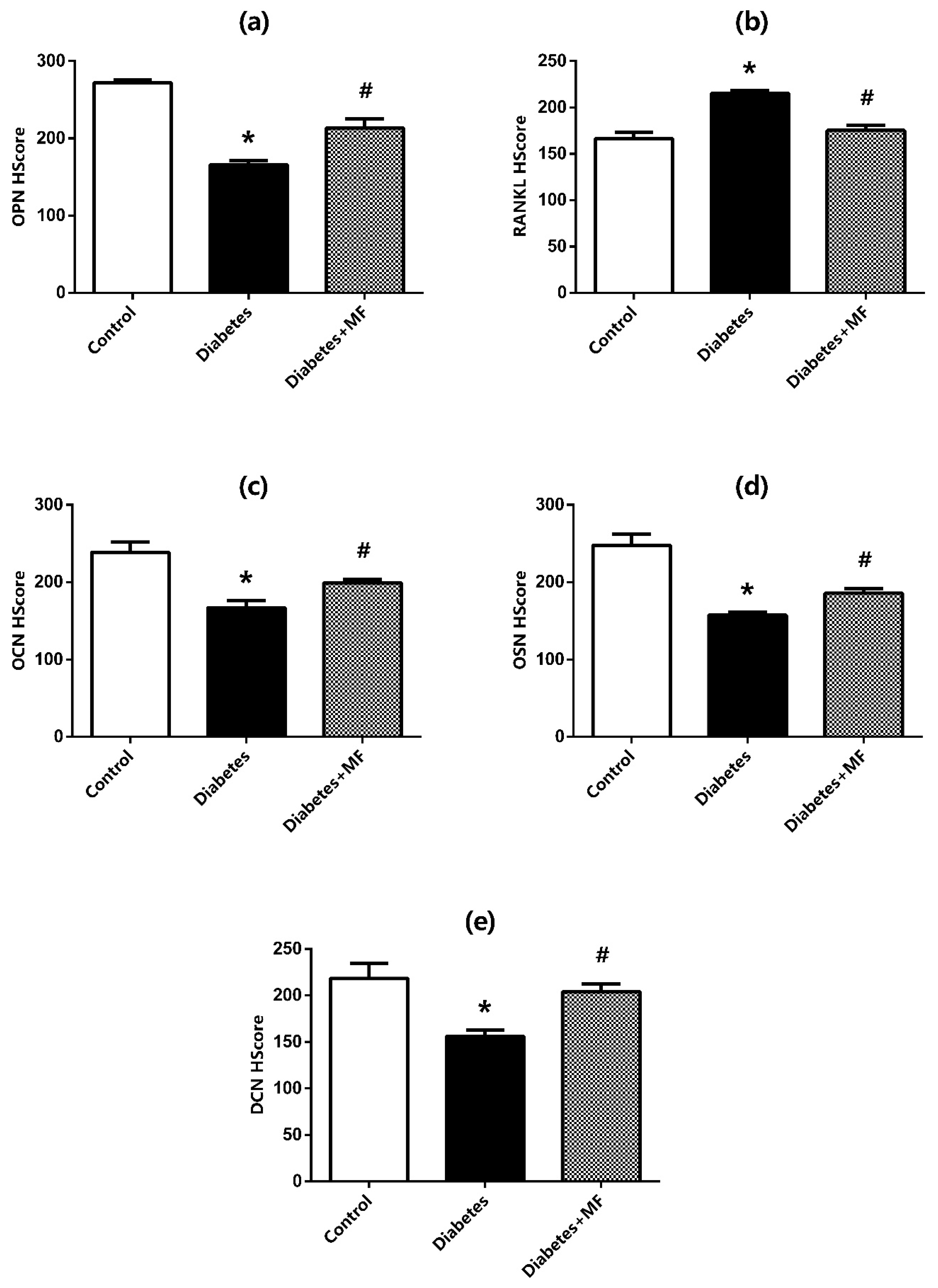
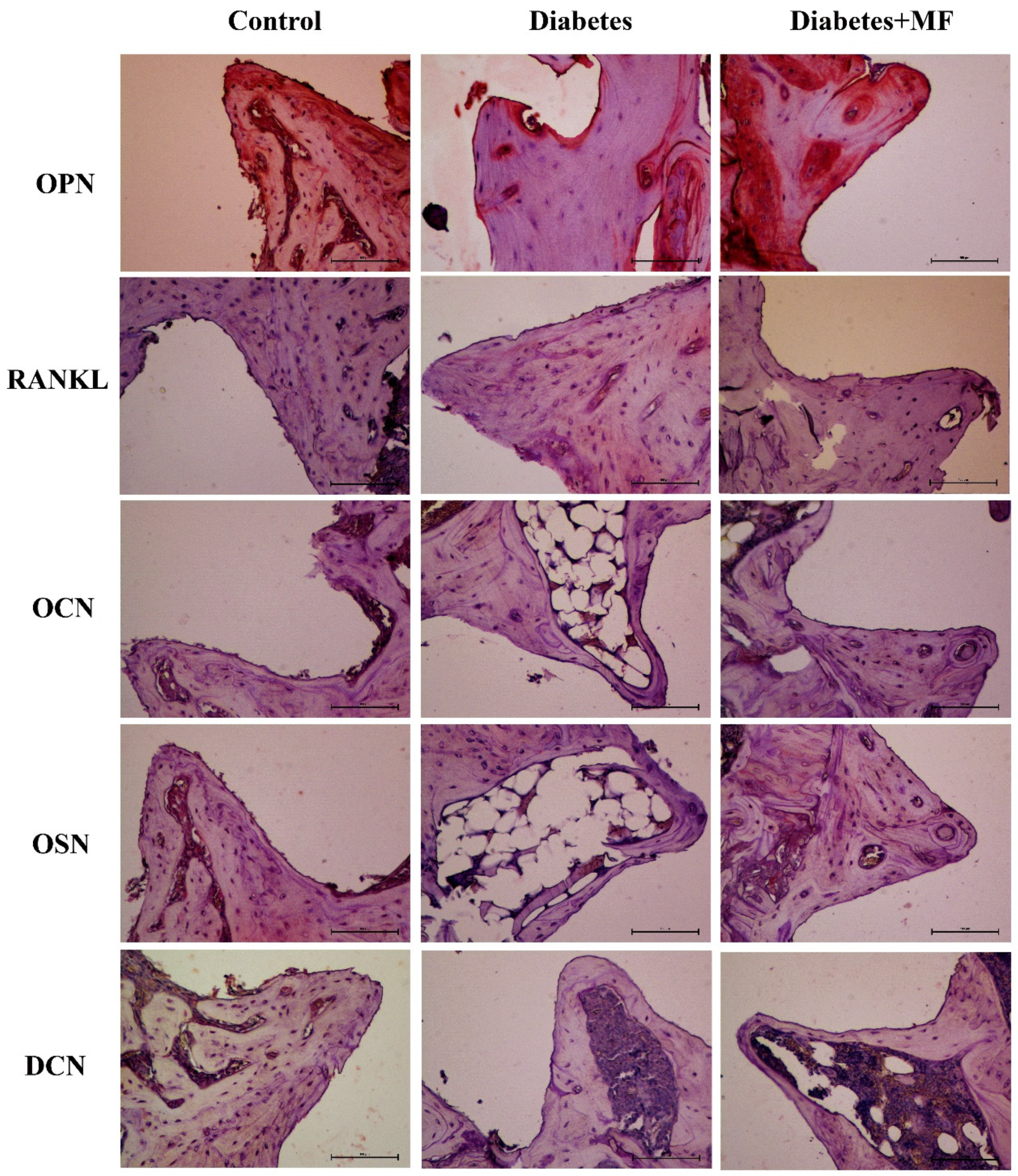
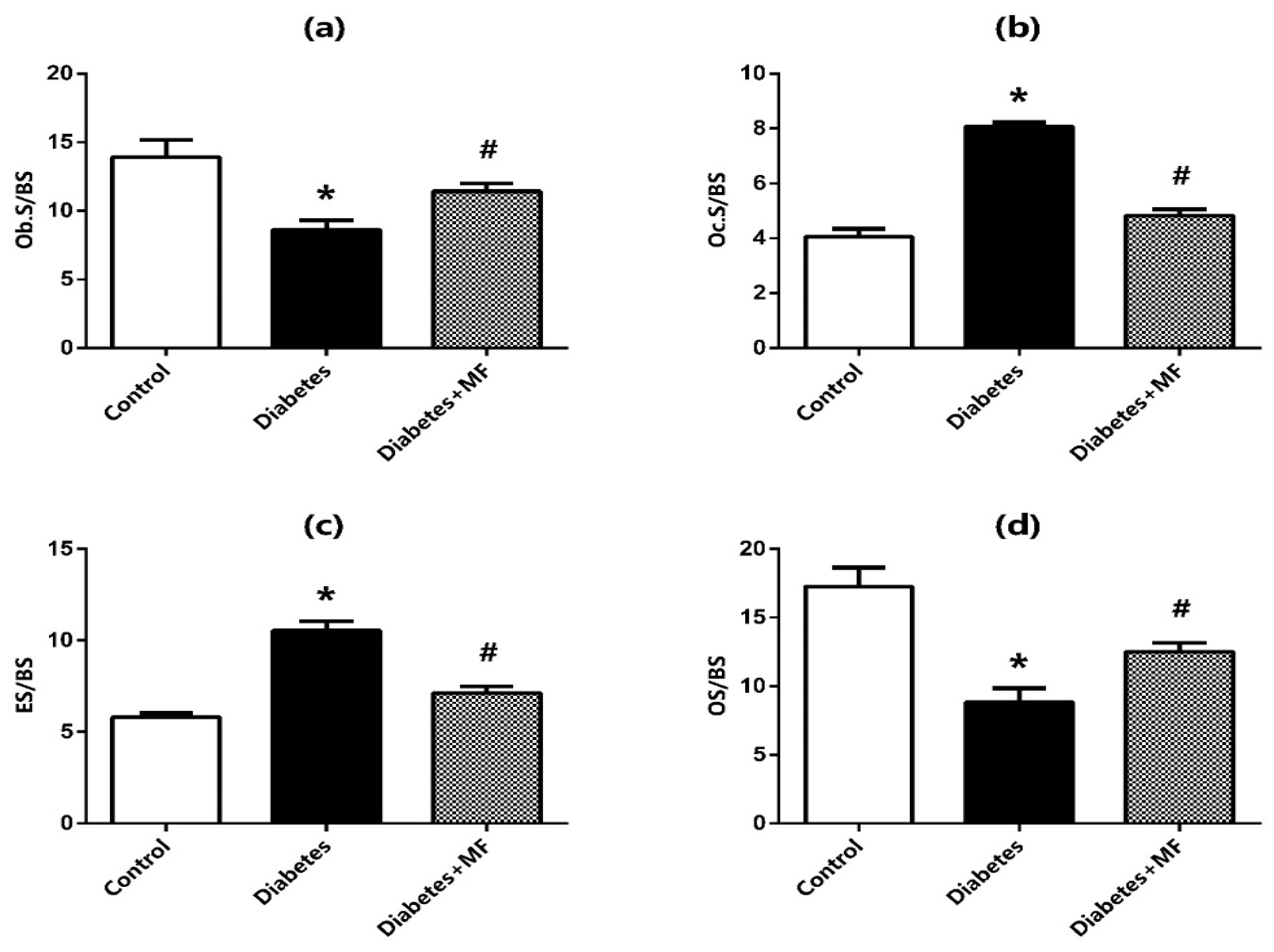

| Gene | Forward Primer Sequence (5′ → 3′) | Reverse Primer Sequence (3′ → 5′) | Product Length (bp) |
|---|---|---|---|
| BMP-2 | CACGAGAATGGACGTGCCC | GCTTCAGGCCAAACATGCTG | 249 |
| DKK1 | CTCAGTGTGGCACTTACCTG | TCTGCACCCTAGAGACAAAAG | 200 |
| IBSP | AGGCAACGAGTACAACACTG | CATAGCCATGCCCCTTGTAG | 116 |
| LRP5 | GAGATTGACTGCATCCCTGG | GAGACAGACAGCATCGCAG | 159 |
| OCN | CGCTACCTCAACAATGGACT | AACACATGCCCTAAACGGTG | 166 |
| OPN | CGATCGATAGTGCCGAGAAG | TGAAACTCGTGGCTCTGATG | 112 |
| OSN | GGAAGCTGCAGAAGAGATGG | GGTCTTGTTGTCATTGCTGC | 286 |
| OSP | CTAGACAAGCAGGGGTAGGT | AACGTTGGGGGCAATATCAA | 222 |
| RANKL | CCCATCGGGTTCCCATAAAG | CAGGTTATGCGAACTTGG GA | 241 |
| RUNX2 | CGCCTCACAAACAACCACAG | TCACTGCACTGAAGAGGCTG | 225 |
| GAPDH | TGATGACATCAAGAAGGTGGTGAAG | TCCTTGGAGGCCATGTGGGCCAT | 249 |
| Groups | Control | Diabetes | Diabetes + MF | |||||
|---|---|---|---|---|---|---|---|---|
| Initial Weight | Final Weight | Initial Weight | Final Weight | p | Initial Weight | Final Weight | p | |
| Weight (g) | 331 ± 6 | 400 ± 7 | 322 ± 5 | 447 ± 10 a | 0.003 | 328 ± 4 | 410 ± 9 b | <0.0001 |
| Glucose (mg/dL) | 131.9 ± 6.8 | 156.1 ± 13.2 | 0.13 | 133.8 ± 6.4 | 0.16 | |||
| Triglyceride (mg/dL) | 67.4 ± 10.6 | 236.4 ± 2.5 a | <0.0001 | 119.6 ± 3.8 b | <0.0001 | |||
| VLDL (mg/dL) | 13.5 ± 2.1 | 47.3 ± 5 a | <0.0001 | 23.8 ± 0.8 b | 0.001 | |||
| ALT (U/L) | 45 ± 6.2 | 64.1 ± 4.5 a | 0.03 | 45.1 ± 1.9 b | 0.003 | |||
| AST (U/L) | 106.3 ± 15 | 137.5 ± 18 | 0.21 | 116.6 ± 7.5 b | 0.001 | |||
| ALP (U/L) | 3.5 ± 0.2 | 10 ± 1.3 a | 0.0006 | 6.3 ± 0.2 b | 0.02 | |||
| Creatinine (mg/dL) | 0.34 ± 0.02 | 0.38 ± 0.02 | 0.19 | 0.32 ± 0.01 b | 0.02 | |||
| Urea (mg/dL) | 41.6 ± 1 | 50.5 ± 2.1 a | 0.003 | 37.8 ± 1.5 b | 0.0006 | |||
| Uric acid (mg/dL) | 0.61 ± 0.06 | 1.33 ± 0.05 a | <0.0001 | 0.78 ± 0.09 b | 0.0003 | |||
| Phosphorus (mg/dL) | 3.2 ± 0.2 | 4.5 ± 0.3 a | 0.004 | 3.3 ± 0.05 b | 0.003 | |||
| Na (mEq/L) | 141.4 ± 0.5 | 137 ± 1.3 a | 0.01 | 141.1 ± 0.6 b | 0.01 | |||
Disclaimer/Publisher’s Note: The statements, opinions and data contained in all publications are solely those of the individual author(s) and contributor(s) and not of MDPI and/or the editor(s). MDPI and/or the editor(s) disclaim responsibility for any injury to people or property resulting from any ideas, methods, instructions or products referred to in the content. |
© 2024 by the authors. Licensee MDPI, Basel, Switzerland. This article is an open access article distributed under the terms and conditions of the Creative Commons Attribution (CC BY) license (https://creativecommons.org/licenses/by/4.0/).
Share and Cite
Ongan, B.; Ekici, Ö.; Sadi, G.; Aslan, E.; Pektaş, M.B. Mangiferin Induces Post-Implant Osteointegration in Male Diabetic Rats. Medicina 2024, 60, 1224. https://doi.org/10.3390/medicina60081224
Ongan B, Ekici Ö, Sadi G, Aslan E, Pektaş MB. Mangiferin Induces Post-Implant Osteointegration in Male Diabetic Rats. Medicina. 2024; 60(8):1224. https://doi.org/10.3390/medicina60081224
Chicago/Turabian StyleOngan, Bünyamin, Ömer Ekici, Gökhan Sadi, Esra Aslan, and Mehmet Bilgehan Pektaş. 2024. "Mangiferin Induces Post-Implant Osteointegration in Male Diabetic Rats" Medicina 60, no. 8: 1224. https://doi.org/10.3390/medicina60081224
APA StyleOngan, B., Ekici, Ö., Sadi, G., Aslan, E., & Pektaş, M. B. (2024). Mangiferin Induces Post-Implant Osteointegration in Male Diabetic Rats. Medicina, 60(8), 1224. https://doi.org/10.3390/medicina60081224






